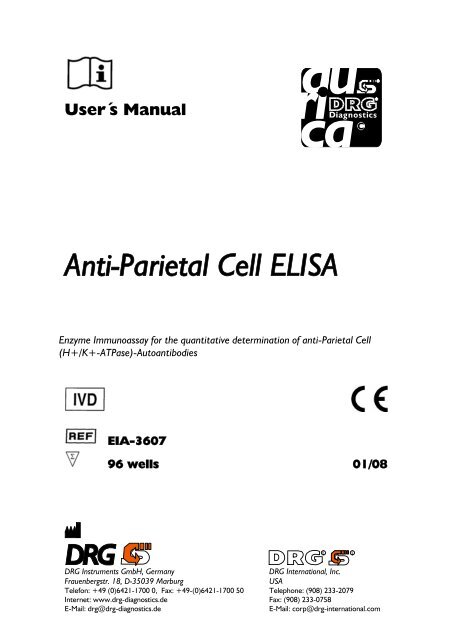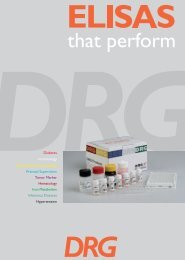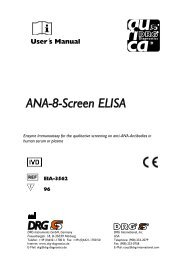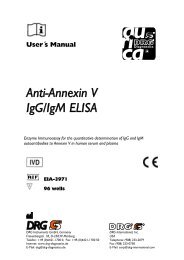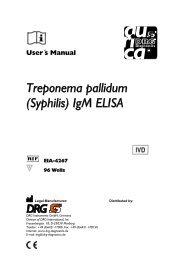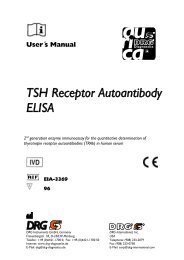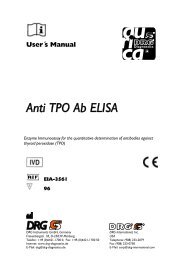EIA-3607 96 wells 01/08 - DRG Diagnostics GmbH
EIA-3607 96 wells 01/08 - DRG Diagnostics GmbH
EIA-3607 96 wells 01/08 - DRG Diagnostics GmbH
Create successful ePaper yourself
Turn your PDF publications into a flip-book with our unique Google optimized e-Paper software.
User´s Manual<br />
Anti-Parietal Cell ELISA<br />
Enzyme Immunoassay for the quantitative determination of anti-Parietal Cell<br />
(H+/K+-ATPase)-Autoantibodies<br />
<strong>EIA</strong>-<strong>3607</strong><br />
<strong>96</strong> <strong>wells</strong> <strong>01</strong>/<strong>08</strong><br />
<strong>DRG</strong> Instruments <strong>GmbH</strong>, Germany <strong>DRG</strong> International, Inc.<br />
Frauenbergstr. 18, D-35039 Marburg USA<br />
Telefon: +49 (0)6421-1700 0, Fax: +49-(0)6421-1700 50 Telephone: (9<strong>08</strong>) 233-2079<br />
Internet: www.drg-diagnostics.de Fax: (9<strong>08</strong>) 233-0758<br />
E-Mail: drg@drg-diagnostics.de E-Mail: corp@drg-international.com
<strong>DRG</strong> Anti-Parietal Cell ELISA <strong>EIA</strong>-<strong>3607</strong><br />
Version 2.0<br />
Effective, January 20<strong>08</strong> (E-Aug. 2005)<br />
(It- <strong>08</strong>/2004)<br />
Table of Contents<br />
1 NAME AND INTENDED USE ................................................................................................................... 2<br />
2 SUMMARY AND EXPLANATION OF THE TEST .................................................................................... 2<br />
3 PRINCIPLE OF THE TEST....................................................................................................................... 2<br />
4 WARNINGS AND PRECAUTIONS........................................................................................................... 3<br />
5 CONTENTS OF THE KIT ......................................................................................................................... 3<br />
6 STORAGE AND STABILITY..................................................................................................................... 3<br />
7 MATERIALS REQUIRED.......................................................................................................................... 4<br />
8 SPECIMEN COLLECTION, STORAGE AND HANDLING ....................................................................... 4<br />
9 PROCEDURAL NOTES............................................................................................................................ 4<br />
10 PREPARATION OF REAGENTS ............................................................................................................. 5<br />
11 TEST PROCEDURE................................................................................................................................. 5<br />
12 INTERPRETATION OF RESULTS........................................................................................................... 6<br />
13 PERFORMANCE CHARACTERISTICS................................................................................................... 7<br />
14 LIMITATIONS OF PROCEDURE ............................................................................................................. 7<br />
15 INTERFERING SUBSTANCES ................................................................................................................ 7<br />
16 REFERENCES.......................................................................................................................................... 8<br />
Tabella die Contenuti<br />
1 CONTENUTO DEL KIT............................................................................................................................. 9<br />
2 AVVERTENZEE PRECAUZZIONI............................................................................................................ 9<br />
3 CONSERVAZIONE E STABILITÁ .......................................................................................................... 10<br />
4 MATERIALE NECESSARIO ................................................................................................................... 10<br />
5 RACCOLTA, CONSERVAZIONE,MANIPOLAZIONE DEI CAMPIONI .................................................. 10<br />
6 AVVERTENZE OPERATIVE .................................................................................................................. 10<br />
7 PREPARAZIONE DEI REAGENTI ......................................................................................................... 11<br />
8 ESECUZIONE DEL TEST ...................................................................................................................... 11<br />
9 INTERPRETAZIONE DEI RISULTATI.................................................................................................... 12<br />
10 PRESTAZIONI DEL KIT ......................................................................................................................... 12<br />
SYMBOLS USED WITH <strong>DRG</strong> ASSAY´S ........................................................................................................ 13<br />
Version 2.0; <strong>01</strong>/20<strong>08</strong> - vk - 1 -
<strong>DRG</strong> Anti-Parietal Cell ELISA <strong>EIA</strong>-<strong>3607</strong><br />
1 NAME AND INTENDED USE<br />
Anti-Parietal Cell is an indirect solid phase enzyme immunoassay (ELISA) for the quantitative measurement of<br />
IgG class autoantibodies against a- and b-subunits of the Parietal Cell H+/K+-ATPase in human serum or<br />
plasma. The assay is intended for in vitro diagnostic use only as an aid in the diagnosis of pernicious anaemia.<br />
2 SUMMARY AND EXPLANATION OF THE TEST<br />
Circulating autoantibodies to gastric parietal cells have been first detected in patients with pernicious anemia by<br />
the complement fixation test, described by Irvine et al. 1<strong>96</strong>2 and following with an immunofluorescence test<br />
described by Taylor et al. 1<strong>96</strong>2. The responsible parietal cell autoantigen was localised to the secretory<br />
canaliculi of gastric parietal cells and to gastric microsomes. Further biochemical and molecular investigations<br />
identified the responsible antigens as a- and b-subunit of the gastric H/K ATPase.<br />
The gastric H/K ATPase (EC 3.6.1.3) is a hydrogen transporting enzyme, responsible for the acidifi-cation of the<br />
stomach lumen (Rabon and Reuben, 1990). It belongs to the family of electroneutral P-type ATPases which<br />
also include the Na/K and the Ca ATPases (Pederson and Carfoli, 1987). This parietal cell antigen consists of<br />
two subunits, an 8-10 transmem-brane catalytic a-subunit of 1033 amino acids and a heavily glycosilated<br />
b-subunit with a 294 amino acid core. This H/K ATPase shows a high degree of conservation in the amino acid<br />
sequence across species (van Driel and Callaghan, 1995).<br />
Pernicious anemia is the most common cause of vitamin B12 deficiency in Western populations. Longitudinal<br />
studies suggest, that pernicious anemia is the end stage of type A chronic atrophic gas-tritis (Irvine et al. 1974),<br />
a disease characterised by pathological lesions of the fundus and body of the stomach, including gastric<br />
mucosal atrophy, selective loss of parietal and chief cells from the gastric mucosa and submucosal lymphocytic<br />
infiltrates (Whittingham and Macckay, 1985).<br />
Pernicious anemia is predominately a disease of middle age northern white Europeans and females show a<br />
higher incidence than males. Patients with pernicious anemia appear pale, physically tired and mentally<br />
depressed. Pernicious anemia associates with a number of other diseases and these are predominantly organ<br />
specific autoimmune diseases of endocrine glands, in which autoantibodies to other tissue specific antigens are<br />
also present. The specific diseases include Hashimoto's thyroiditis, diabetes melitus Type 1 and primary<br />
Addison's disease (Whittingham and Macckay, 1985). Late stages of pernicious anemia may also be associated<br />
with peripheral neuropathy and subacute combined degeneration of the spinal cord due to vitamin B12<br />
deficiency.<br />
Autoantibodies against the H/K ATPase can be detected in 80-90% of pernicious anemia patients, by indirect<br />
immunofluorescence and they are also detected in 2-5% of the healthy adult population. ELISA test systems<br />
show a sensitivity of about 80% and specificity of about 90%. There is an age related increase in the presence<br />
of parietal cell autoantibodies in the adult population. A study of the relationship between parietal cell<br />
autoantibody and gastric mucosal morphology, indicates these parietal cell positive individuals in a random<br />
population may indeed have early type A gastritis (Uibo et al., 1984). Higher prevalence rates (20-30%) of<br />
parietal cell autoantibodies have been noted in patients with autoimmune endocrine disorders such as<br />
thyrotoxicosis, Hashimoto's thyroiditis and insu-lin dependent diabetes (Whittingham and Macckay, 1985).<br />
Histological examinations of gastric biopsies reveals that the majority of parietal cell autoantibody positive<br />
individuals also have a type A gastric lesion (Varis et al. 1979).<br />
3 PRINCIPLE OF THE TEST<br />
Highly purified pig Parietal Cell H+/K+-ATPase is bound to micro<strong>wells</strong>. Antibodies against this antigen, if present<br />
in diluted serum or plasma, bind to the respective antigen. Washing of the micro<strong>wells</strong> removes unspecific serum<br />
and plasma components. Horseradish peroxidase (HRP) conjugated anti-human IgG immunologically detects<br />
the bound patient antibodies forming a conjugate/antibody/antigen complex. Washing of the micro<strong>wells</strong> removes<br />
unbound conjugate. An enzyme substrate in the presence of bound conjugate hydrolyzes to form a blue color.<br />
The addition of an acid stops the reaction forming a yellow end-product. The intensity of this yellow color is<br />
measured photometrically at 450 nm. The amount of colour is directly proportional to the concentration of IgG<br />
antibodies present in the original sample.<br />
Version 2.0; <strong>01</strong>/20<strong>08</strong> - vk - 2 -
<strong>DRG</strong> Anti-Parietal Cell ELISA <strong>EIA</strong>-<strong>3607</strong><br />
4 WARNINGS AND PRECAUTIONS<br />
1. All reagents of this kit are strictly intended for in vitro diagnostic use only.<br />
2. Do not interchange kit components from different lots.<br />
3. Components containing human serum were tested and found negative for HBsAg, HCV, HIV1 and HIV2 by<br />
FDA approved methods. No test can guarantee the absence of HBsAg, HCV, HIV1 or HIV2, and so all<br />
human serum based reagents in this kit must be handled as though capable of transmitting infection.<br />
4. Avoid contact with the TMB (3,3´,5,5´-Tetramethyl-benzidine). If TMB comes into contact with skin, wash<br />
thoroughly with water and soap.<br />
5. Avoid contact with the Stop Solution which is hydrochloric acid (1 M). If it comes into contact with skin, wash<br />
thoroughly with water and seek medical attention.<br />
6. Some kit components (i.e. Controls, Sample buffer and Buffered Wash Solution) contain Sodium Azide as<br />
preservative. Sodium Azide (NaN3) is highly toxic and reactive in pure form. At the product concentrations,<br />
though not hazardous. Despite the classification as non-hazardous, we strongly recommend using prudent<br />
laboratory practices (see 8., 9., 10.).<br />
7. Some kit components contain Proclin 300 as preservative. When disposing reagents containing Proclin 300,<br />
flush drains with copious amounts of water to dilute the components below active levels.<br />
8. Wear disposable gloves while handling specimens or kit reagents and wash hands thoroughly afterwards.<br />
9. Do not pipette by mouth.<br />
10. Do not eat, drink, smoke or apply makeup in areas where specimens or kit reagents are handled.<br />
11. Avoid contact between the buffered Peroxide Solution and easily oxidized materials; extreme temperature<br />
may initiate spontaneous combustion.<br />
Observe the guidelines for performing quality control in medical laboratories by assaying controls and/or pooled<br />
sera. During handling of all kit reagents, controls and serum samples observe the existing legal regulations.<br />
5 CONTENTS OF THE KIT<br />
Package size <strong>96</strong> determ.<br />
Qty.1 Divisible microplate consisting of 12 modules of 8 <strong>wells</strong> each, coated with highly<br />
purified pig H+/K+-ATPase, a- and b-subunits. Ready to use.<br />
6 vials, 1.5 ml each Standards: Anti-Parietal Cell Calibrators (A-F) in a serum/buffer matrix (PBS, BSA,<br />
NaN3
<strong>DRG</strong> Anti-Parietal Cell ELISA <strong>EIA</strong>-<strong>3607</strong><br />
7 MATERIALS REQUIRED<br />
Equipment<br />
− Microplate reader capable of endpoint measurements at 450 nm<br />
− Multi-Channel Dispenser or repeatable pipet for 100 µl<br />
− Vortex mixer<br />
− Pipets for 10 µl, 100 µl and 1000 µl<br />
− Laboratory timing device<br />
− data reduction software<br />
Preparation of reagents<br />
− distilled or deionized water<br />
− graduated cylinder for 100 and 1000 ml<br />
− plastic container for storage of the wash solution<br />
8 SPECIMEN COLLECTION, STORAGE AND HANDLING<br />
1. Collect whole blood specimens using acceptable medical techniques to avoid hemolysis<br />
2. Allow blood to clot and separate the serum by centrifugation<br />
3. Test serum should be clear and non-hemolyzed. Contamination by hemolysis or lipemia is best avoided, but<br />
does not interfere with this assay.<br />
4. Specimens may be refrigerated at 2-8 °C for up to five days or stored at –20 °C up to six months.<br />
5. Avoid repetitive freezing and thawing of serum samples. This may result in variable loss of autoantibody<br />
activity<br />
6. Testing of heat-inactivated sera is not recommended<br />
9 PROCEDURAL NOTES<br />
1. Do not use kit components beyond their expiration dates<br />
2. Do not interchange kit components from different lots<br />
3. All materials must be at room temperature (20-28 °C)<br />
4. Have all reagents and samples ready before start of the assay. Once started, the test must be performed<br />
without interruption to get the most reliable and consistent results.<br />
5. Perform the assay steps only in the order indicated<br />
6. Always use fresh sample dilutions<br />
7. Pipette all reagents and samples into the bottom of the <strong>wells</strong><br />
8. To avoid carryover contamination change the tip between samples and different kit controls<br />
9. It is important to wash micro<strong>wells</strong> thoroughly and remove the last droplets of wash buffer to achieve best<br />
results.<br />
10. All incubation steps must be accurately timed<br />
11. Control sera or pools should routinely be assayed as unknowns to check performance of the reagents and<br />
the assay.<br />
12. Do not re-use microplate <strong>wells</strong><br />
For all controls, the respective concentrations are provided on the labels of each vial. Using these<br />
concentrations a calibration curve may be calculated to read off the patient results semi-quantitatively.<br />
Version 2.0; <strong>01</strong>/20<strong>08</strong> - vk - 4 -
10 PREPARATION OF REAGENTS<br />
<strong>DRG</strong> Anti-Parietal Cell ELISA <strong>EIA</strong>-<strong>3607</strong><br />
10.1 Preparation of sample buffer<br />
Dilute the contents of each vial of the sample buffer concentrate (5x) with distilled or deionized water to a final<br />
volume of 100 ml prior to use. Store refrigerated: stable at 2-8 °C for at least 30 days after preparation or until<br />
the expiration date printed on the label.<br />
10.2 Preparation of wash solution<br />
Dilute the contents of each vial of the buffered wash solution concentrate (50x) with distilled or deionized water<br />
to a final volume of 1000 ml prior to use. Store refrigerated: stable at 2-8 °C for at least 30 days after<br />
preparation or until the expiration date printed on the label.<br />
10.3 Sample preparation<br />
Dilute all patient samples 1:100 with sample buffer before assay. Therefore combine 10 µl of sample with 990 µl<br />
of sample buffer in a polystyrene tube. Mix well. Controls are ready to use and need not be diluted.<br />
11 TEST PROCEDURE<br />
1. Prepare a sufficient number of microplate modules to accommodate controls and prediluted patient<br />
samples.<br />
2. Pipet 100 µl of calibrators, controls and prediluted patient samples in duplicate into the <strong>wells</strong>.<br />
1 2 3 4 5 6<br />
A SA SE P1 P5<br />
B SA SE P1 P5<br />
C SB SF P2 P..<br />
D SB SF P2 P.. SA-SF: standards A to F<br />
E SC C1 P3 P1, P2...C: patient sample 1, 2 ...<br />
F SC C1 P3 C1: positive control<br />
G SD C2 P4 C2: negative control<br />
H SD C2 P4<br />
3. Incubate for 30 minutes at room temperature (20-28 °C)<br />
4. Discard the contents of the micro<strong>wells</strong> and wash 3 times with 300 µl of wash solution.<br />
5. Dispense 100 µl of enzyme conjugate into each well<br />
6. Incubate for 15 minutes at room temperature<br />
7. Discard the contents of the micro<strong>wells</strong> and wash 3 times with 300 µl of wash solution<br />
8. Dispense 100 µl of TMB substrate solution into each well<br />
9. Incubate for 15 minutes at room temperature<br />
10. Add 100 µl of stop solution to each well of the modules and incubate for 5 minutes at room temperature<br />
11. Read the optical density at 450 nm and calculate the results. Bi-chromatic measurement with a reference at<br />
600-690 nm is recommended.<br />
The developed colour is stable for at least 30 minutes. Read optical densities during this time.<br />
11.1 Automation<br />
The Anti-Parietal Cell ELISA is suitable for use on open automated ELISA processors. The test procedure<br />
detailed above is appropriate for use with or without automation.<br />
Version 2.0; <strong>01</strong>/20<strong>08</strong> - vk - 5 -
12 INTERPRETATION OF RESULTS<br />
<strong>DRG</strong> Anti-Parietal Cell ELISA <strong>EIA</strong>-<strong>3607</strong><br />
12.1 Quality Control<br />
This test is only valid if the optical density at 450 nm for Positive Control (1) and Negative Control (2) as well as<br />
for the Calibrator A and F complies with the respective range indicated on the Quality Control Certificate<br />
enclosed to each test kit !<br />
If any of these criteria is not fulfilled, the results are invalid and the test should be repeated.<br />
12.2 Calculation of results<br />
For Anti-Parietal Cell a 4-Parameter-Fit with lin-log coordinates for optical density and concentration is the data<br />
reduction method of choice.<br />
12.2.1 Recommended Lin-Log Plot<br />
First calculate the averaged optical densities for each calibrator well. Use lin-log graph paper and plot the<br />
averaged optical density of each calibrator versus the concentration. Draw the best fitting curve approximating<br />
the path of all calibrator points. The calibrator points may also be connected with straight line segments. The<br />
concentration of unknowns may then be estimated from the calibration curve by interpolation.<br />
12.3 Calculation example<br />
The figures below show typical results for Anti-Cardiolipin IgG/IgM ELISA. These data are intended for<br />
illustration only and should not be used to calculate results from another run.<br />
Calibrators<br />
No Position OD 1 OD 2 Mean Conc. 1 Conc. 2 Mean decl. Conc. CV %<br />
STA A 1/B 1 0.<strong>01</strong>6 0.<strong>01</strong>6 0.<strong>01</strong>6 0.00 0.00 0.00 0.0 0.0<br />
STB C 1/D 1 0.332 0.335 0.334 6.45 6.40 6.43 6.3 0.6<br />
STC E 1/F 1 0.548 0.558 0.553 12.0 12.2 12.1 12.5 1.3<br />
STD G 1/H 1 0.934 0.956 0.945 25.6 24.8 25.2 25.0 1.6<br />
STE A 2/B 2 1.410 1.386 1.398 51.0 50.0 50.5 50.0 1.2<br />
STF C 2/D 2 1.823 1.840 1.832 98.3 1<strong>01</strong>.1 99.7 100.0 1.8<br />
12.4 Interpretation of results<br />
In a normal range study with serum samples from healthy blood donors the following ranges have been<br />
established with the Anti-Parietal Cell test:<br />
anti-Parietal Cell-Ab<br />
normal: < 10 U/ml<br />
elevated: > 10 U/ml<br />
Positive results should be verified concerning the entire clinical status of the patient. Also every decision for<br />
therapy should be taken individually. It is recommended that each laboratory establishes its own normal and<br />
pathological ranges of serum anti-Parietal Cell antibodies.<br />
Version 2.0; <strong>01</strong>/20<strong>08</strong> - vk - 6 -
<strong>DRG</strong> Anti-Parietal Cell ELISA <strong>EIA</strong>-<strong>3607</strong><br />
13 PERFORMANCE CHARACTERISTICS<br />
13.1 Precision (Reproducibility)<br />
Statistics for Coefficients of variation (CV) were calculated for each of three samples from the results of 24<br />
determinations in a single run for Intra-Assay precision. Run-to-run precision was calculated from the results of<br />
5 different runs with 6 determinations of each sample:<br />
Sample<br />
No<br />
Intra-Assay Inter-Assay<br />
Mean<br />
(U/ml)<br />
CV<br />
(%)<br />
Sample<br />
No<br />
Version 2.0; <strong>01</strong>/20<strong>08</strong> - vk - 7 -<br />
Mean<br />
(U/ml)<br />
CV<br />
(%)<br />
1 12.5 3.5 1 12.0 4.2<br />
2 22.5 2.8 2 20.5 3.7<br />
3 75.0 3.2 3 85.9 2.6<br />
13.2 Sensitivity<br />
The lower detection limit for Anti-Parietal Cell has been determined at 0.5 U/ml.<br />
13.3 Specificity<br />
The microplate is coated with highly purified H+/K+-ATPase from pig Parietal Cells. The test kit is specific only<br />
for autoantibodies against the Parietal Cell antigen.<br />
13.4 Calibration<br />
Since no international reference preparation for Anti-Parietal Cell autoantibodies is available, the assay system<br />
is calibrated in relative arbitrary units.<br />
14 LIMITATIONS OF PROCEDURE<br />
The Anti-Parietal Cell ELISA is a diagnostic aid. A definite clinical diagnosis should not be based on the results<br />
of a single test, but should be made by the physician after all clinical and laboratory findings have been<br />
evaluated.<br />
15 INTERFERING SUBSTANCES<br />
No interference has been observed with haemolytic (up to 1000 mg/dL), lipemic (up to 3 g/dL triglycerides) or<br />
bilirubin (up to 40 mg/dL) containing sera. Nor have any interfering effects been observed with the use of<br />
anticoagulants. However for practical reasons it is recommended that grossly hemolyzed or lipemic samples be<br />
avoided.
<strong>DRG</strong> Anti-Parietal Cell ELISA <strong>EIA</strong>-<strong>3607</strong><br />
16 REFERENCES<br />
1. Irvine, W. J., Davies, S. H., Delamore, I. W., Williams, A. W.. Immunological relationship between<br />
pernicious anemia and thyroid disease.<br />
Br. Med. J. 1<strong>96</strong>2, pp. 454-456.<br />
2. Taylor, K. B., Roitt, I. M., Doniach, D., Couchman, K. G., Shapland, C.. Autoimmune phenomena in<br />
pernicious anemia: gastric antibodies.<br />
Br. Med. J. 1<strong>96</strong>2, pp. 1347-1352.<br />
3. Rabon, E. C. and Reuben M. A.. The mechanism and structure of the gastric H/K-ATPase.<br />
Annu. Rev. Physiol. 1990, No. 52, pp. 321-344.<br />
4. Pedersen, P. L. and Carfoli, E.. Ion motive ATPases. I. Ubiquity properties and significance to cell function.<br />
Trends Biochem Sci 1987, No. 12, pp. 146-149.<br />
5. Van Driel, I. R., Callaghan, J. M.. Proton and potassium transport by H/K ATPases.<br />
Clin. Exp. Pharmacol. Physiol. 1995.<br />
6. Irvine, W. J., Cullen, D. R., Mawhinney, H.. Natural history of autoimmune achlorhydric atrophic gastritis.<br />
A 1-15 year follow up study.<br />
Lancet 1974, No. 2, pp. 482-485.<br />
7. Whittingham, S., Mackay, I. R.. Pernicious anemia and gastric atrophy. In: Rose, N. R., Mackay, I. R. eds.<br />
The Autoimmune Diseases. New York, Academic Press 1985, pp. 243-266.<br />
8. Uibo, R., Krohn, K., Villako, K., Tammur, T., Tamm, A.. The relationship of parietal cell, gastrin cell and<br />
thyroid autoantibodies to the state of the gastric mucosa in a population sample. Scand.<br />
J. Gastroenterol. 1984, No. 19, pp. 1075-1<strong>08</strong>0.<br />
9. Varis, K., Ihamako, T., Harkonen, M., Samloff, I. M., Siurala, M.. Gastric morphology, function and<br />
immunology in first degree relatives of probands with pernicious anemia and controls.<br />
Scand. J. Gastroenterol. 1979, No. 14, pp. 129-139.<br />
Version 2.0; <strong>01</strong>/20<strong>08</strong> - vk - 8 -
<strong>DRG</strong> Anti-Parietal Cell ELISA <strong>EIA</strong>-<strong>3607</strong><br />
Test immunometrico per la determinazione quantitativa degli autoanticorpi anti-cellule parietali gastriche della<br />
classe IgG<br />
Per uso diagnostico in vitro esclusivo.<br />
1 CONTENUTO DEL KIT<br />
1 Microplate: Micropiastra a pozzetti separabili costituita da 12 strip da 8 pozzetti<br />
ciascuno, sensibilizzata con antigene cellule parietali gastriche ((H+/K+) ATPasi).<br />
Pronta all'uso.<br />
6 flaconi da 1,5 mL cad. Standards: Calibratori contenenti anticorpi di classe IgG anti-cellule parietali<br />
gastriche in matrice serica tamponata (PBS, BSA, Sodio Azide< 0,1%(p/p) alle<br />
seguenti concentrazioni di IgG: 0; 6.3; 12.5; 25; 50; 100 U/ml. Pronti all'uso.<br />
2 flaconi da 1,5 mL cad. Controls: Controllo positivo (1) e negativo (2) anti-cellule parietali gastriche in<br />
matrice serica tamponata (PBS, BSA, Sodio Azide< 0,1% (p/p); le rispettive<br />
concentrazioni sono riportate nel foglietto illustrativo. Pronti all'uso.<br />
1 flacone da 20 mL Sample Buffer: Diluente campioni (TRIS, Sodio Azide
<strong>DRG</strong> Anti-Parietal Cell ELISA <strong>EIA</strong>-<strong>3607</strong><br />
3 CONSERVAZIONE E STABILITÁ<br />
1. Conservare il kit a 4-8°C.<br />
2. Mantenere la micropiastra sigillata in una busta,con essicante,a tenuta di umidità.<br />
3. I reagenti sono stabili fino alla scadenza riportata sul kit.<br />
4. Mantenere i reagenti al riparo da calore,sole,luce solare diretta durante la conservazione e l'uso.<br />
5. Il tampone diluente il campione e il tampone di lavaggio sono stabili almeno 30 gg, se conservati a<br />
2-8°C,dopo la loro preparazione.<br />
4 MATERIALE NECESSARIO<br />
Strumentazione<br />
− Lettore di micropiastre con possibilità di misurazione end point, a 450 nm<br />
− Dispensatore multicanale o pipetta sequenziale da 100 ml<br />
− Pipette da 10,100,1000 ml<br />
− Agitatore di tipo vortex<br />
− Orologio da laboratorio<br />
− Software per l'elaborazione dei dati<br />
Preparazione dei reagenti<br />
− acqua distillata o deionizzata<br />
− cilindri graduati da 100 mL e 1000 mL<br />
− bottiglie di plastica per la conservazione della soluzione di lavaggio<br />
5 RACCOLTA, CONSERVAZIONE,MANIPOLAZIONE DEI CAMPIONI<br />
1. Il prelievo di sangue deve essere eseguito con le modalità necessarie per evitare l'emolisi del campione.<br />
2. Attendere che il campione sia coagulato e separare il siero per centrifugazione.<br />
3. Verificare che il siero sia non emolizzato. Sebbene emolisi e lipidi non interferiscono nella determinazione,è<br />
opportuno l'uso di campioni non lipemici e non emolizzati.<br />
4. I campioni possono essere conservati a 4-8°C fino a 5 giorni,oppure a -20°C fino a 6 mesi.<br />
5. Evitare di congelare e scongelare ripetutamente i campioni di siero. Ciò può causare una perdita di attività<br />
auto anticorpale.<br />
6. Non è raccomandato testare sieri inattivati col calore.<br />
6 AVVERTENZE OPERATIVE<br />
1. Non usare kit scaduti<br />
2. Non intercambiare componenti di kit con diversi numeri di lotto<br />
3. Tutti i materiali devono essere conservati a temperatura ambiente<br />
4. Preparare tutte le soluzioni di lavoro prima di iniziare il ciclo analitico;questo deve essere completato senza<br />
interruzioni al fine di ottenere risultati affidabili e coerenti<br />
5. Utilizzare la procedura analitica indicata<br />
6. Usare sempre campioni freschi<br />
7. Pipettare reagenti e campioni sul fondo del pozzetto<br />
8. Lavare accuratamente i pozzetti e rimuovere tutte le goccioline di tampone di lavaggio al fine di ottenere i<br />
risultati più corretti<br />
9. Rispettare accuratamente i tempi di incubazione<br />
10. Cambiare i puntali dopo la dispensazione di ciascun campione e dei controlli,al fine di evi-tare fenomeni di<br />
trascinamento<br />
11. I sieri e i pool serici di controllo vanno trattati come campioni anonimi al fine di valutare le prestazioni dei<br />
reagenti<br />
12. Non riutilizzare piastre già usate Le concentrazioni dei controlli sono riportate sulle rispettive<br />
etichette;utilizzando queste con-centrazioni è possibile costruire una curva di taratura ed ottenere dei<br />
risultati semiquantitati-vi.<br />
Version 2.0; <strong>01</strong>/20<strong>08</strong> - vk - 10 -
<strong>DRG</strong> Anti-Parietal Cell ELISA <strong>EIA</strong>-<strong>3607</strong><br />
7 PREPARAZIONE DEI REAGENTI<br />
7.1 Preparazione del Diluente campioni<br />
Prima dell'uso, diluire il contenuto di ciascun flacone di Diluente campioni concentrato 5X con acqua distillata o<br />
deionizzata fino a un volume finale di 100 ml. Conservare in frigorifero: la sta-bilità è di almeno 30 gg a 2-8°C<br />
dalla data di preparazione,o fino alla data di scadenza stam-pata in etichetta.<br />
7.2 Preparazione del Tampone di Lavaggio<br />
Prima dell'uso,diluire il contenuto di ciascun flacone di tampone di lavaggio concentrato 50X con acqua distillata<br />
o demonizzata fino a un volume finale di 1000 ml. Conservare in frigorifero: la stabilità è di almeno 30 gg a<br />
2-8°C dalla data di preparazione,o fino alla data di scaden-za stampata in etichetta.<br />
7.3 Preparazione dei campioni<br />
Diluire tutti i campioni 1:100 con il Diluente campioni. Dispensare 10 µl di campione in 990 µl Diluente campioni<br />
in una provetta di plastica. Miscelare bene. I controlli sono pronti per l'uso e non necessitano di diluizioni.<br />
8 ESECUZIONE DEL TEST<br />
1. Prelevare il numero di strip necessario per l'analisi in funzione del numero di campioni, controlli e calibratori<br />
2. Dispensare nei rispettivi pozzetti 100 µl dei calibratori,controlli e campioni prediluiti.<br />
3. Incubare per 30' a temperatura ambiente (20-28°C)<br />
4. Svuotare i pozzetti e lavare 3 volte con 300 µl di soluzione di lavaggio<br />
5. Dispensare 100 µl di coniugato in ciascun pozzetto<br />
6. Incubare per 15' a T.A.<br />
7. Svuotare i pozzetti e lavare 3 volte con 300 µl di soluzione di lavaggio<br />
8. Dispensare 100 µl di TMB in ciascun pozzetto<br />
9. Incubare per 15' a T.A.<br />
10. Dispensare 100 µl di Soluzione Stoppante a ciascun pozzetto<br />
11. Leggere la Densità Ottica a 450 nm e calcolare il risultato. E' raccomandata una lettura in bicromatismo con<br />
una lunghezza d'onda di riferimento a 600-690 nm.<br />
Il colore è stabile per almeno 30'. Leggere la Densità Ottica in questo periodo di tempo.<br />
Version 2.0; <strong>01</strong>/20<strong>08</strong> - vk - 11 -
<strong>DRG</strong> Anti-Parietal Cell ELISA <strong>EIA</strong>-<strong>3607</strong><br />
9 INTERPRETAZIONE DEI RISULTATI<br />
9.1 Controllo di Qualità<br />
Il test è valido solo se la D.O. a 450 nm per il controllo positivo (1) e controllo negativo (2),così pure per il<br />
calibratore A e F cadono nei limiti indicati nel Certificato di Controllo di Qualità alle-gato a ciascun kit. Se tutti<br />
questi criteri non sono riscontrati,i risultati devono essere conside-rati non validi e il test deve essere ripetuto.<br />
9.2 Calcolo dei risultati<br />
L'elaborazione della curva dose/risposta raccomandata è quella logaritmica lineare a 4 para-metri;possono<br />
essere utilizzate anche curve log-log o Smoothed spline.<br />
9.2.1 Curva logaritmica Lin-Log<br />
Calcolare la D.O. media per ciascun pozzetto contenente i calibratori. Usare una carta diagram-mata lin-log,<br />
riportare la media delle D.O e le rispettive concentrazioni,quindi estrapolare la curva. Alternativamente,costruire<br />
una curva collegando punto per punto i singoli punti di calibrazione. La concentrazione dei campioni da<br />
analizzare è determinata tramite la curva di cali-brazione così estrapolata.<br />
9.3 Interpretazione dei risultati<br />
Anti-cellule parietali gastriche IgG<br />
normale: < 10 U/ml<br />
positivo: ≥ 10 U/ml<br />
I risultati positivi devono essere confermati con un esame clinico del paziente.Ogni decisione clinica deve<br />
essere presa sulla base di una valutazione clinica individuale.<br />
10 PRESTAZIONI DEL KIT<br />
Precisione: Intra-assay:2.8 - 3.5 %;<br />
Inter-assay:2.6 - 4.2 %<br />
Sensibilità: 0.5 U/ml<br />
Version 2.0; <strong>01</strong>/20<strong>08</strong> - vk - 12 -
SYMBOLS USED WITH <strong>DRG</strong> ASSAY´S<br />
<strong>DRG</strong> Anti-Parietal Cell ELISA <strong>EIA</strong>-<strong>3607</strong><br />
Symbol English Deutsch Français Español Italiano<br />
Consult instructions for<br />
use<br />
European Conformity<br />
In vitro diagnostic<br />
device<br />
RUO For research use only<br />
Gebrauchsanweisung<br />
beachten<br />
CE-Konfirmitätskennzeichnung<br />
In-vitro-Diagnostikum<br />
Nur für<br />
Forschungszwecke<br />
Consulter les<br />
instructions d’utilisation<br />
Conformité aux<br />
normes européennes<br />
Usage Diagnostic<br />
in vitro<br />
Seulement dans le<br />
cadre de recherches<br />
Consulte las<br />
instrucciones de uso<br />
Consultare le istruzioni<br />
per l’uso<br />
Conformidad europea Conformità europea<br />
Para uso Diagnóstico<br />
in vitro<br />
Sólo para uso en<br />
investigación<br />
Per uso Diagnostica in<br />
vitro<br />
Solo a scopo di ricerca<br />
Catalogue number Katalog-Nr. Numéro de catalogue Número de catálogo Numero di Catalogo<br />
Lot. No. / Batch code Chargen-Nr. Numéro de lot Número de lote Numero di lotto<br />
Contains sufficient for<br />
tests/<br />
Ausreichend für ”n”<br />
Ansätze<br />
Storage Temperature Lagerungstemperatur<br />
Expiration Date<br />
Mindesthaltbarkeitsdatum<br />
Contenu suffisant pour<br />
”n” tests<br />
Température de<br />
conservation<br />
Contenido suficiente<br />
para ensayos<br />
Temperatura de<br />
conservación<br />
Contenuto sufficiente<br />
per ”n” saggi<br />
Temperatura di<br />
conservazione<br />
Date limite d’utilisation Fecha de caducidad Data di scadenza<br />
Legal Manufacturer Hersteller Fabricant Fabricante Fabbricante<br />
Distributed by Distributor Vertreiber Distributeur Distribuidor Distributore<br />
Content Content Inhalt Conditionnement Contenido Contenuto<br />
Volume/No. Volume / No. Volumen/Anzahl Volume/Quantité Volumen/Número Volume/Quantità<br />
RUO<br />
Symbol Portugues Dansk Svenska Ελληνικά<br />
Distributed by<br />
Consulte as instruções<br />
de utilização<br />
Conformidade com as<br />
normas europeias<br />
Se brugsanvisning Se bruksanvisningen Εγχειρίδιο χρήστη<br />
Europaeisk<br />
overensstemmelse<br />
Europeisk<br />
överensstämmelse<br />
Ευρωπαϊκή<br />
Συμμόρφωση<br />
Diagnóstico in vitro In vitro diagnostik Diagnostik in vitro in vitro διαγνωστικό<br />
Catálogo n.º Katalognummer Katalog nummer Αριθμός καταλόγου<br />
No do lote Lot nummer Batch-nummer Αριθμός Παρτίδος<br />
Temperatura de<br />
conservação<br />
Indeholder<br />
tilsttrækkeligt til ”n” test<br />
Opbevaringstemperatur<br />
Innehåller tillräckligt till<br />
“n” tester<br />
Förvaringstempratur<br />
Περιεχόμενο επαρκές<br />
για «n» εξετάσεις<br />
Θερμοκρασία<br />
αποθήκευσης<br />
Prazo de validade Udløbsdato Bäst före datum Ημερομηνία λήξης<br />
Fabricante Producent Tillverkare Κατασκευαστής<br />
Content Conteúdo Indhold Innehåll Περιεχόμενο<br />
Volume/No. Volume/Número Volumen/antal Volym/antal Όγκος/αριθ..<br />
Version 2.0; <strong>01</strong>/20<strong>08</strong> - vk - 13 -


